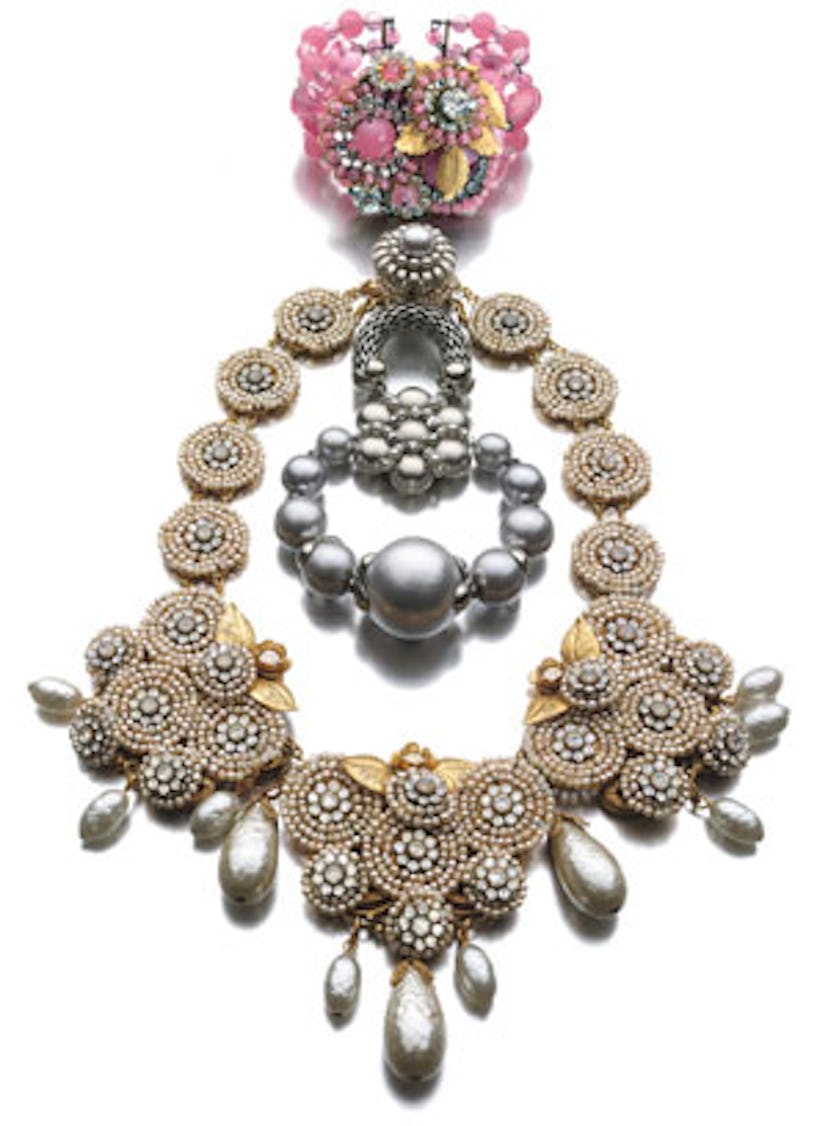Sleeping Beauty

If, as they say, timing is everything, this is the moment to stir Miriam Haskell, the storied-but-slumbering costume jewelry house now poised for a comeback, 83 years after its founding. Such a notion might seem contrary to the current economic situation, but Haskell has history on its side: The label was built on the brink of the Great Depression and flourished because of it.
Miriam Haskell, in the Thirties, courtesy of Malcolm H. Dubin, Cincinnati.
For the uninitiated, Miriam Haskell was a premier American fashion jewelry house for the better part of the 20th century; today it is a prized resource for vintage collectors, who snap up its baubles for upwards of $3,000. Which is to say that it has the kind of reputation and heritage prime for revival—though such wasn’t the case about 20 years ago, when the firm changed hands. “When we bought the company, it was virtually out of business,” says Gabrielle Fialkoff, chief operations officer of Miriam Haskell. Her father, Frank Fialkoff, purchased the label under the parent company Haskell Jewels in 1990, just in time for minimalism to send a hush over costume jewelry. “It wasn’t a jewelry moment, so we just got quiet, feeling that the time would be right in the future,” says Fialkoff. Buoyed by the hot trend in bold statement pieces that started with Lanvin in 2003—and continues today with Balenciaga, Louis Vuitton, and the Tom Binnses and Philip Crangis of the world—Miriam Haskell relaunched in fall 2007, and Henri Bendel was happy to re-engage the brand. As Bendel’s fashion director, Ann Watson, puts it, “Coco Chanel is the foremother of costume jewelry in Europe, and Miriam Haskell is the foremother of costume jewelry for Americans.”
Indeed, Haskell’s story is compelling: humble beginnings, startling success and a tragic conclusion, all centered on a bold, eccentric character. Haskell was born in 1899 in Indiana. She moved to New York and opened a bijoux shop in the McAlpin Hotel in 1926, when costume jewelry was a relatively new genre, one ushered in by the wildly popular Coco Chanel, who had launched her vrais bijoux en toc, or “real fake jewelry,” collection in 1924.
Haskell capitalized on the American obsession with French fashion, modeling her own collection—most of it handmade from imported glass beads and crystal—after European costume jewelry. The idea wasn’t to imitate the real but to create fanciful fakes inspired by nature and exotic cultures, a novel concept at the time. “Her jewelry was the only [line] in America that could compete with the French—Chanel and Schiaparelli,” says Deanna Farneti Cera, author of The Jewels of Miriam Haskell. She notes that Haskell probably designed the first few pieces herself, yet the collection’s enduring aesthetic, marked by a metal filigree covered with clusters of beads and, most famously, glass pearls, is largely owed to Frank Hess, the label’s designer from 1926 to 1960. “The Forties and Fifties are the most collectible period,” says vintage jewelry maven Carole Tanenbaum. “Few [of those] pieces remain for sale.”
In the house’s prime, Haskell devotees included Lucille Ball and Joan Crawford, whose extensive collection was found, upon her death in 1977, meticulously labeled and stored in her home and was later auctioned off by New York’s Plaza Art Galleries.
Even while the country was deep into the Depression, Miriam Haskell boomed. The parallels between now and then haven’t escaped Fialkoff, who, while hardly thrilled by today’s economy, is optimistic. “Our customer is looking to update last season’s outfit with a great piece of costume,” she says. “She wants to stand out and not spend what she would on fine jewelry.” Which is just the mind-set that propelled Miriam Haskell in the Thirties.
Yet things didn’t remain so rosy for long. Haskell began showing symptoms of depression and obsessive-compulsive disorder; by 1950 her mental state had deteriorated to the point where she was unable to work, and her brother took over the business.
Haskell died in 1981 at age 82, leaving a legacy as a modern American woman with a head for business and an eye for fashion. Today her distinctive taste remains at the company’s core. Current designs include woven pearl necklaces and nature motifs made of suede, wood and brass. The collection—which ranges from $500 to $2,000 and, in addition to Henri Bendel, is carried at Nordstrom, Fred Segal and Harvey Nichols—is still made completely by hand. Many pieces utilize the house’s vast supply of vintage beads and filigrees, but not to old-fashioned effect. “We ask ourselves, ‘What would Miriam be doing today?’” says Fialkoff. “But we never want to imitate it, because she never imitated.”
Styled by Brooke Magnaghi; Haskell: Courtesy of Malcom H. Dubin and Idea Books, Milano